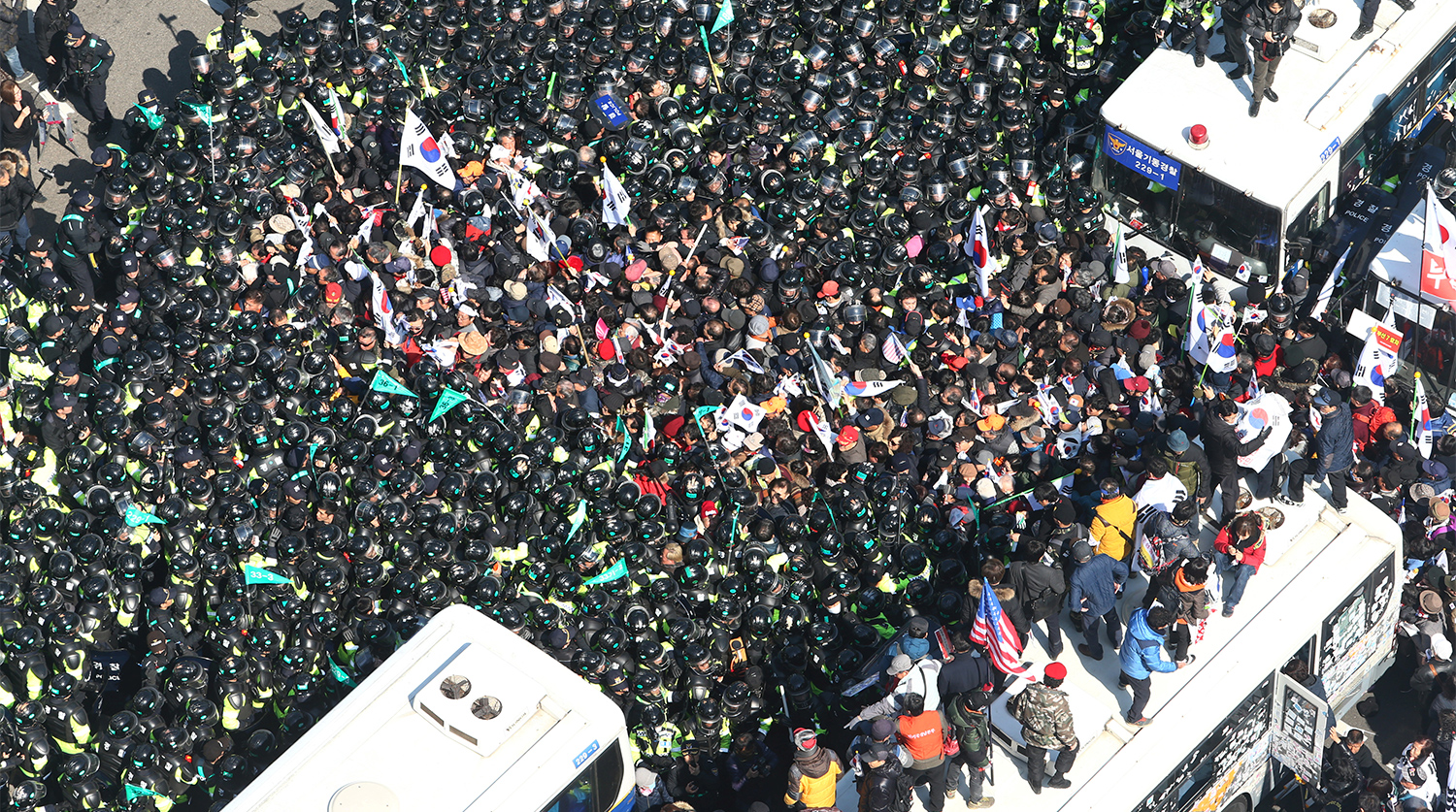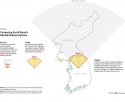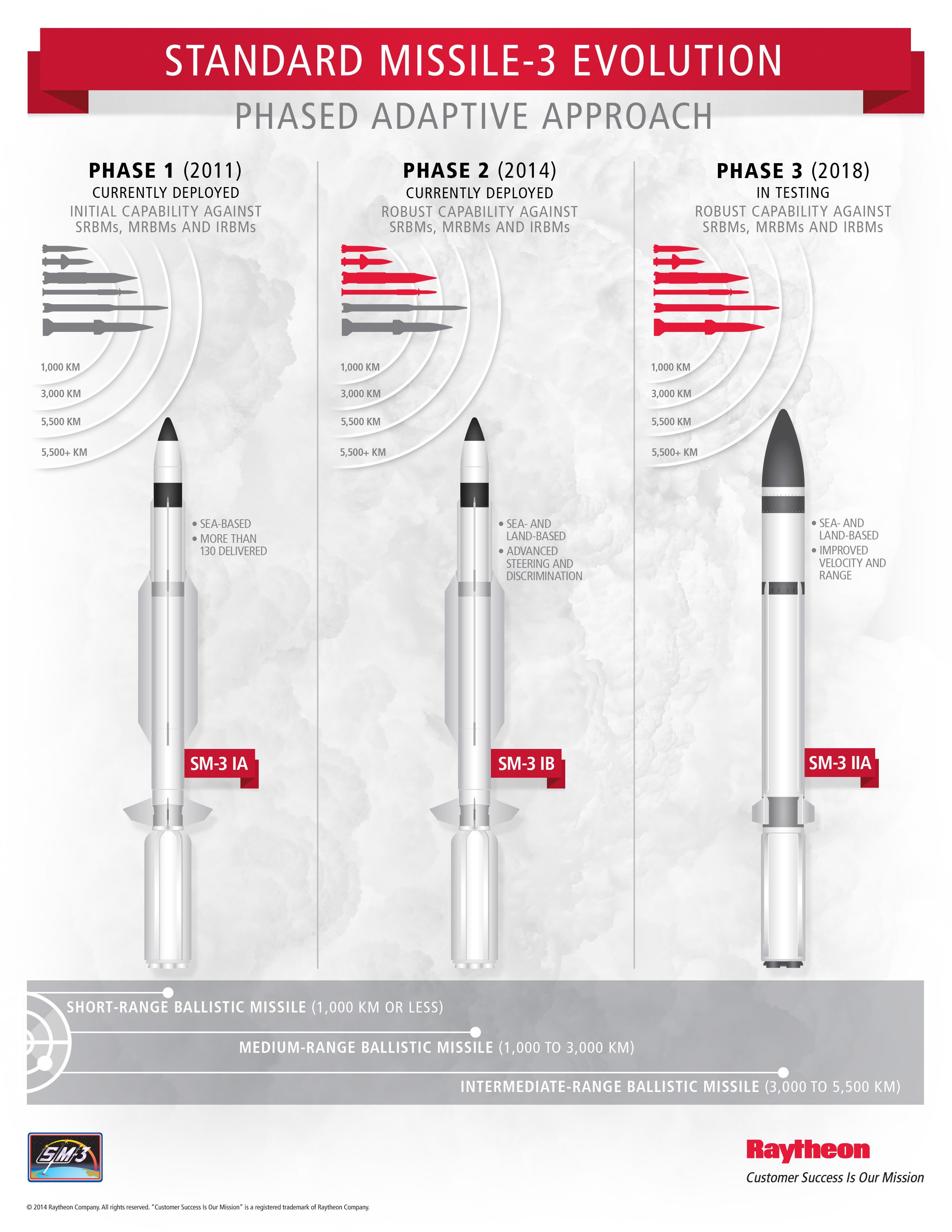You are using an out of date browser. It may not display this or other websites correctly.
You should upgrade or use an alternative browser.
You should upgrade or use an alternative browser.
South Korean Military News, Reports, Data, etc.
- Thread starter IDonT
- Start date
TerraN_EmpirE
Tyrant King
Jura The idiot
General
stunning picture:

EDIT it's from the photo gallery at
Dec 18, 2016
now a different look ...:in the context of Hyunmoo-2 slash -3 range (500 slash 1500 km) etc. I quickly scrambled this:
in red: 500 km radius centered at which seemed to me to be the most distant from any sea ... so it's interesting they announced only the missiles with this range for the newest sub https://www.sinodefenceforum.com/so...ews-reports-data-etc.t260/page-38#post-429109
by the way I wished I knew the Far East geography better LOL

Last edited:
Destroy BMs NK is not the job for SK BMs make sense with aircrafts, LACM mainly US.
BMs are used mainly vs bases coz more fast very difficult to intercept as a LACM subsonic but in general less accurate dépends mainly range more she is important less good is the accuracy.
THAAD capable intercepted BM with a range of 1800 km ? to confirm
NK BMs the more numerous are Hwasong family 5-6-7 based on Scud in fact 300 - 900 km, Rodong 1300 -2000 km others are not operationnals. also KN-02/SS-21 120 km,100 for a total of 900 - 1300 without SR KN-02 how many launchers we can guestimate at less 1 TEL for 5 missiles maybe more, so 200 ?
Pac-3 vs BM range max 1100 km, SM-3 3000 - 5000 km for newvariants, SM-6 inferior, GBI normaly able vs ICBM.

BMs are used mainly vs bases coz more fast very difficult to intercept as a LACM subsonic but in general less accurate dépends mainly range more she is important less good is the accuracy.
THAAD capable intercepted BM with a range of 1800 km ? to confirm
NK BMs the more numerous are Hwasong family 5-6-7 based on Scud in fact 300 - 900 km, Rodong 1300 -2000 km others are not operationnals. also KN-02/SS-21 120 km,100 for a total of 900 - 1300 without SR KN-02 how many launchers we can guestimate at less 1 TEL for 5 missiles maybe more, so 200 ?
Pac-3 vs BM range max 1100 km, SM-3 3000 - 5000 km for newvariants, SM-6 inferior, GBI normaly able vs ICBM.

Last edited:
Jura The idiot
General
Feb 6, 2017
Better Tech Is Arriving to Defend Against North Korean Missiles. It Won’t Cool Regional Tensions
is the post related to what I read now:related:

comes from inside of
VIDEO: New SM-3 Block IIA Intercepts Ballistic Missile in Space For First Time
Better Tech Is Arriving to Defend Against North Korean Missiles. It Won’t Cool Regional Tensions
Next year, the U.S. plans to deploy a shipboard interceptor to help protect Japan. China and Russia will not be amused.
The new anti-missile system the U.S. is sending to South Korea is a far-from-perfect solution. Though it will help protect Seoul against North Korean missiles, it antagonizes China while leaving allies like Japan still vulnerable. Next year, a new shipboard interceptor is slated to arrive in the region, promising more protection — and more controversy.
On Monday, U.S. troops the Terminal High Altitude Area Defense, or THAAD, anti-missile batteries in South Korea. The deployment, announced last year and sped up by several months after a, brings to the Korean peninsula land-based missile launchers and sophisticated radars. China views the move as hostile because the radars could allow the U.S. to better track some Chinese missiles.
“It’s a classic case of a , where actions taken by one country in response to the actions of another—here the deployment of enhanced U.S.[missile defense] capabilities to offset North Korea’s growing missile capabilities—complicate relations with a third player,” Rod Lyon explained in .
Beijing’s worry is rooted in a Cold War-ish anxiety about deterrence. A nuclear-armed adversary that can destroy your ability to wage war has more incentive to launch a first strike against you. By no means would THAAD’s deployment give the United States any sort of serious advantage if World War III were to break out. But it might give the U.S. a smidge of extra early-detection capability. And nuclear deterrence is an area where superpowers are disinclined to surrender even an inch.
What THAAD does not do is offer protection from North Korean missiles much beyond the Korean peninsula.
“THAAD would improve defense of South Korea, and U.S. forces deployed there, but would not have sufficient range to defend Japan,” Heritage Foundation senior researcher Bruce Klingner.
So the United States, with Japan, is looking to deploy a new interceptor system. It would use Raytheon’s Standard Missile-Three, or , to offer a defense against North Korean mid-range missiles, working with an radar system common to many ships called the Aegis (after the shield of Zeus in Greek mythology). The U.S. currently has Aegis deployed on . By 2020, Aegis four Japanese destroyers as well.
The Space Bullet
The SM-3 differs from the THAAD missile in worldly ambition and physical reach. Whereas THAAD is designed to take out missiles as they descend through the endoatmosphere — that is, less than 100 kilometers up — the SM-3s are designed to intercept missiles beyond the Earth’s atmosphere, the so called exoatmosphere. So while THAAD’s missiles are intended to hit missiles as they are rocketing back to Earth, SM-3s are designed to hit them in space. That allows a warship firing the SM-3 to protect a larger area.
This is one reason why the Obama Administration on SM-3s as a means to curb North Korea’s missile ambitions, at least those ambitions related to short- and mid-range missiles. It was to be a kind of silver bullet. The military soon found that while hitting a bullet with a bullet is hard enough beneath the 100-kilometer ceiling, it is harder in space. SM-3s missed what they were supposed to be hitting during tests in 2012 and 2015.
But the continual miniaturization of electronics, enabling ever-smaller processors to crunch more data, eventually allowed engineers to approach the challenge of exoatmospheric missile interception from a new angle.
Today, the eyes and brains of the newest SM-3s function very differently than those of its predecessors. Lenses and mirrors that would narrowly focus on an object at a great distance, like a telescope, gave way to one that was more broad but did not see as far, like a panoramic lens. Better onboard processors, and more data from external satellites, radars, and other sensors, allowed the system to better differentiate targets with less detailed visual data.
Mitch Stevison, vice president of Raytheon missile systems, described it as the difference between looking through a soda straw and using full peripheral vision.
“You have one picture and then you start looking at object, object, object, picking out the objects, and then correlating the objects to say, ‘not a threat, threat, potential threat, not a threat.’ Then you make decisions on what to do with that much more efficiently than you could with the old systems,” said Stevison. “Certainly the advancing [computer] capabilities gives us the ability to process more data…The advanced processing and advanced algorithms, with the advanced discrimination capabilities, all of those things put together gives us a confidence.”
In February, the Pentagon that the newest version of the missile, the SM-3 IIA, had launched from a warship off Hawaii and intercepted a target in the exoatmosphere. Combined with THAAD, the U.S. now had a defense against intermediate-range missiles at multiple altitudes.
In theory, that sort of deterrent should convince North Korea to stop its missile tests. Since North Korean test missiles can be destroyed well above the Earth’s atmosphere, why waste money on them?
Its potential effects on Pyongyang notwithstanding, the new weapon is unlikely to calm international fears, according to other experts.
“Everybody’s going to complain that that’s a bad thing to do,” said RAND analyst Bruce Bennett, regarding shooting down North Korean test missiles with Aegis warships. “It is aggressive. It is risky. But these missile launches have been sanctioned by multiple UN Security Council resolutions. They’re illegal.”
Physicist and arms control watcher said SM-3-equipped warships would not be welcomed by China or Russia.
“Deployment of more Aegis systems to this area is a major irritant to both China and Russia, which see these systems as building toward a future capability that could threaten their ability to respond to a US first strike,” Gubrud said. “One can argue that it is better to have some chance of stopping a nuclear missile than none. But this must be balanced against the risk that pursuing an arms race makes the eventual launch of that missile more likely. With or without missile defense, we are stuck with the same need to avoid a major war which could lead to nuclear weapons use.”
For evidence of that, look to Poland. In the wake of its successful tests, the Aegis/SM-3 system will proliferate to , part of an expanded missile defense agenda championed by the Obama Administration. “All of these milestones were riding on the success of this test,” said Stevison.
Adversaries aren’t likely to stop innovating simply because the U.S. has a new missile. In the future, “it is also possible for North Korea to add countermeasures that would drastically reduce the system’s effectiveness,” Gubrudsi.
The Pentagon is already worried about how North Korea and other actors might adapt to the new development by fitting future missiles with multiple heads, or decoys, that diverge after launch. The military is eyeing the new so-called multi-object kill vehicles in response. “I’m really careful about talking about threats because those immediately go into areas that we can’t really talk about,” said Stevison. “I would characterize it like this. The pace that we see the potential adversaries testing should tell us something.”
Today’s THAAD is tomorrow’s SM-3 IIA, which shall beget more sons and daughters not yet fully conceived. The lesson, if there is one: technology does not end arms races. Unaccompanied by policy, it is merely an accelerant.
Blackstone
Brigadier
Looks like Zhongnanhai is steadily boiling the ROK frog one degree at a time as punishment for hosting THAAD, and without a US-lead TPP, Seoul has fewer options to resist Beijing. Ultimately, it isn't in most people's interests to have an economic recession in South Korea, but for now, it'll face the fury of defying Chinese security interests.
SEOUL (THE KOREA HERALD/ASIA NEWS NETWORK) - The South Korean economy, already struggling with sluggish domestic consumption, rising household debt and youth joblessness, is facing double shocks from its two biggest economic partners - China and the United States.
The most immediate threat comes from China, which has been stepping up its economic retaliation against South Korea's decision to host an advanced US missile defence system.
The Chinese retaliation, which started when South Korea and the US decided last July to deploy a Terminal High-Altitude Area Defence (Thaad) battery in Sangju, North Gyeongsang Province, has now reached a level where South Korean residents and visitors, as well as businesses there, are advised to be cautious about their safety.
China accounts for nearly a quarter of South Korea's foreign trade and a deterioration in this bilateral economic relationship would have severe repercussions for the economy.
The tourism sector is one of the industries being heavily affected by Chinese retaliation, which started with a ban on group tours to South Korea and the cancellation of charter flights between the two countries.
Most recently, Chinese authorities last week instructed travel agents not to sell tour programmes to South Korea. The South Korean travel industry should brace for a difficult time, because almost half of its foreign tourists come from China.
China is also targeting Lotte Group, Korea's fifth-largest conglomerate, for providing a golf course to the Thaad battery. Various Lotte units in China have already been harassed by discriminatory tax audits and safety inspections. Some of its retail units have been kicked off of online shopping malls, and Chinese authorities suspended more than 20 Lotte Mart discount stores, citing violation of firefighting regulations.
Chinese media now threaten that other Korean companies like Samsung and Hyundai Motor could face the same fate as Lotte.
A bigger problem is there are signs of brewing anti-Korean public sentiment among the Chinese public. Two Chinese men were charged with damaging Hyundai cars. Chinese protesters picketed Korean retail shops and some of Lotte's websites have been attacked by hackers. An increasing number of Chinese websites and social media carry photos of Korean products being smashed.
These remind us of the fierce, violent anti-Japanese protests that erupted across China in 2012 in the wake of Tokyo's announcement that it had nationalised the Senkaku/Diaoyu Islands. It led to a boycott of Japanese products.
It is certain that China will ratchet up the pressure in the coming months, as South Korea and the US agreed to hasten the Thaad battery deployment. There are enough reasons for Korean officials and businesses to prepare for worse to come.
If the threat from China is an ongoing factor, another external risk - a possible revision of the South Korea-US free trade agreement - is in the making.
During his campaign, US President Donald Trump, whose "America First" policy is based on isolationism and protectionism, criticised free trade pacts like the Korea-US FTA for killing American jobs and leaving the US in deficit.
Reflecting Trump's view, the US Trade Representative, in an official report released last week, strongly indicated that the Trump administration would revise the pact.
The report - President Donald Trump's 2017 Trade Policy Agenda -- said that, compared with before the agreement went into effect in 2012, US exports to South Korea fell by US$1.2 billion (S$1.7 billion), while US imports from South Korea grew by more than US$13 billion.
"Needless to say, this is not the outcome the American people expected from that agreement," it said. "Plainly, the time has come for a major review of how we approach trade agreements."
That exactly reflects the view of Trump who once called the KORUS FTA a "disaster" that only kills American jobs. It may be a matter of time before the US side demands a revision of the free trade agreement.
The recent developments vis-a-vis the US and China show that Korea should brace for uncertainties in the world's two largest markets and its most important economic partners.
A big problem is that the external risks come at a bad time when the Korean economy is stuck in a low-growth trap and consumption slump, and the nation is going through unprecedented political instability.
More worrisome is that the political instability may continue for the time being, regardless of the impending court decision on impeachment of President Park Geun-hye. Which is why government bureaucrats and businesses should be more alert than ever.
lol, they can have fury of North Korean missiles above their heads so it doesn't matter what PRC wants in this case. Anyway, lesson learned - don't ever try to join Team China in the future as they can throw you out easily and try to put your head in the mud if you'll go with your own policy. Good thing that's clear for everyone now.but for now, it'll face the fury of defying Chinese security interests.
Blackstone
Brigadier
You speak gibberish; the "lesson learned" for rational actors is nations pursue their interests and when important or core interests clash, the strong will do what they can and the weak will suffer as they must. Little has changed since the Melian Dialogue.lol, they can have fury of North Korean missiles above their heads so it doesn't matter what PRC wants in this case. Anyway, lesson learned - don't ever try to join Team China in the future as they can throw you out easily and try to put your head in the mud if you'll go with your own policy. Good thing that's clear for everyone now.
